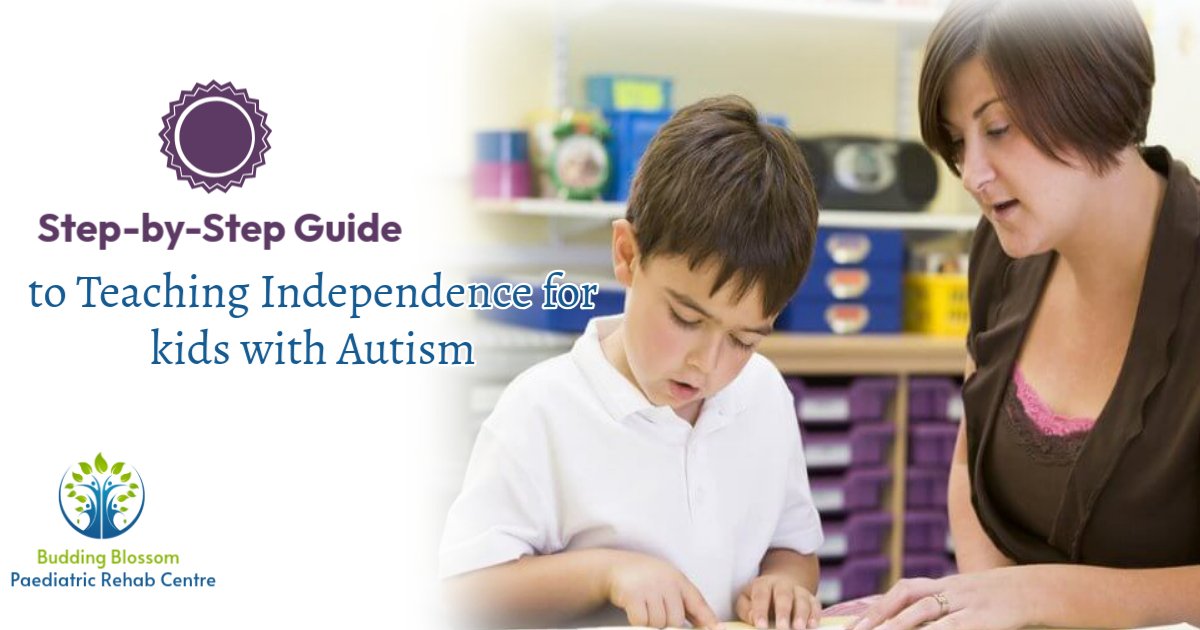
+91- 9444 222850
buddingblossomrehab@gmail.com

As a parent of a child with autism, you know how deeply you care about your child’s future and well-being. One of the greatest gifts you can give them is the ability to be as independent as possible. It’s a gift that not only enhances their confidence but also helps them navigate the world in a way that fosters growth and self-reliance. Teaching independence for children with autism is a journey that requires patience, love, and understanding, but with each step forward, your child will develop the skills they need to thrive.
Here’s a step-by-step guide to help you teach autism independence skills in a way that’s nurturing, supportive, and grounded in love.
Independence doesn’t happen overnight. It’s about building confidence through small victories. When teaching new skills, break things down into manageable, bite-sized tasks. For example, if your child is learning to dress themselves, begin with teaching them how to put on a shirt. Once they’re comfortable with that, add a new piece to the puzzle, like pants or shoes. Every little achievement will build their confidence.
Why it matters: Every small step your child takes toward independence is a success. Celebrate these moments, and remind them how proud you are of their progress, no matter how small it feels. By focusing on autism daily living skills, you lay the foundation for greater independence in the future.
Children with autism often thrive in structured environments. Consistent routines help them feel secure and can make the process of learning new skills more predictable. Set up a daily routine for your child that includes time for self-care, chores, and personal tasks. For example, if you’re teaching your child to make their own lunch, create a simple step-by-step visual schedule they can follow each day.
Why it matters: Creating routines for autistic children gives your child a sense of control and predictability. Over time, these routines will become second nature, and your child will feel more comfortable taking charge of them, promoting autism self-care skills.
Visual aids are incredibly helpful for children with autism. Using pictures or simple written instructions can guide your child through tasks in a way that’s clear and easy to follow. For example, you can use visual schedules, step-by-step charts, or checklists to help them complete everyday tasks like brushing their teeth, getting dressed, or packing their school bag.
Why it matters: Visual supports for autism independence provide clarity, which reduces anxiety and confusion. When your child can see the steps laid out, they are more likely to feel empowered to take the lead.
Children often learn best by watching others. Before asking your child to do something on their own, model it for them. For example, if you’re teaching your child to clean up their toys, show them how to pick up the toys, put them in the basket, and then put the basket back in the closet. Do it slowly, and be patient, making sure they see exactly how to perform the task.
Why it matters: When your child sees you doing the task, they’re better able to understand the steps. It’s a powerful way to teach them through example, and it creates a sense of connection as they follow your lead. This method is a key part of autism life skills training, which is essential for promoting independence in children with autism spectrum disorder.
Start by involving your child in everyday activities. This can include things like folding laundry, setting the table, or feeding the family pet. Even if your child doesn’t do everything perfectly, the goal is to encourage participation and responsibility. Over time, they’ll learn to manage these tasks on their own.
Why it matters: By including your child in family routines, they learn the importance of contributing. It gives them a sense of pride and belonging, helping them see themselves as capable and valued members of the family. This is a great way to foster autism social skills and independence at the same time.
Every step toward independence deserves to be celebrated! Use praise, rewards, or even a simple “thank you” to acknowledge your child’s effort. Positive reinforcement boosts their motivation to keep trying and reinforces their self-worth. Whether it’s verbal praise or a small reward, it’s important to acknowledge their progress.
Why it matters: When your child is praised, they feel encouraged to keep going. They associate their efforts with positive feelings, which makes them more likely to try again. Every bit of encouragement counts, and it strengthens your child’s self-esteem and belief in their ability to be independent.
Patience is key. There will be times when your child struggles or resists trying to do something on their own. It can be frustrating, both for you and for them. But always remember that setbacks are a normal part of the learning process. When these moments happen, take a deep breath, and be gentle with your child. Offer them comfort, guidance, and reassurance.
Why it matters: Patience helps you model emotional regulation for your child, which is an important skill for them to learn as well. When they see you stay calm, they’re more likely to stay calm too. Your unwavering belief in their ability to succeed will make a world of difference as they work on autism independence skills.
Whenever possible, give your child choices. Whether it’s what clothes to wear, what food to eat, or which activity to do, offering choices helps them feel more in control. This can be a great way to encourage decision-making skills and autonomy. Keep the choices simple and manageable, like, “Do you want the red shirt or the blue shirt?”
Why it matters: When your child has the ability to make choices, they feel empowered. It gives them a sense of independence and helps them practice decision-making in a low-pressure way. This is a valuable tool for promoting independence in children with autism spectrum disorder.
Independence is a lifelong skill, and it’s important to set goals that are realistic for your child’s age and abilities. Focus on progress, not perfection. If your child is still learning to brush their teeth independently, it’s okay if they need help with the toothpaste or the brushing technique. The important part is that they’re learning to do it for themselves.
Why it matters: Setting realistic expectations helps avoid frustration. It’s a reminder that independence is a process, not a destination. Celebrate each milestone, no matter how small, and be proud of your child’s efforts to develop autism life skills.
As your child masters simple tasks, gradually increase their responsibilities. Perhaps they can start by setting their own breakfast table and eventually progress to making their own lunch. You can even involve them in planning their own weekly schedule or organizing their homework. Gradually increasing their responsibilities helps build their confidence and self-reliance.
Why it matters: As your child takes on more responsibility, they learn that they are capable of handling bigger tasks. This growth in responsibility strengthens their self-esteem and shows them how much you believe in their ability to succeed.
Teaching independence to a child with autism is one of the most loving things you can do for them. It’s about nurturing their growth, building their confidence, and showing them that they are capable of much more than they often realize. It’s not always easy, and it’s okay to have challenging days. But every small step forward is a victory, and with your love and patience, your child will learn the powerful lesson that they can stand on their own two feet.
You are giving your child the gift of independence, and that is something they will carry with them for a lifetime. Keep moving forward, one step at a time, and remember: you’re doing amazing.